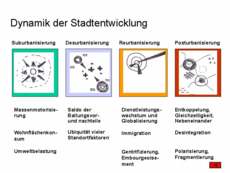index
Problems with the size of nodes
click on images for full-size:

The dynamics of the evolution of cities: Suburbanization (mass automobile use, consumption of dwelling space, environmental stress), (Deurbanization (balance of advantages and disadvantages of agglomeration), Reurbanization (growth of services, immigation, gentrification), Posturbanization (disconnection, simultaneity, adjacency, disintegration, polarization, fragmentation) -- Image used with permission from Prof. Manfed Sinz's lecture on contemporary space issues

Structural models of settlement: Fortress (rings, periphery, Camillo Sitte, von Thünen, Alonso), Railroad (axes and corridors, Isbary, Dietrichs, Kistenmacher), Road Network (grids, planes, Frank Lloyd Wright, Broadacre City), Cybercity (network city, virtual city, Thomas Sieverts, Edward W. Soja, Saskia Sassen). The last two are in-between-cities. -- Image used with permission from Prof. Manfed Sinz's lecture on contemporary space issues

Wright sketched several pictures of Broadacre City, and with his students built a large model showing what a typical area might be like. Some views can be found on the web through Google's image search.
The nodes of Wright's net of places in Broadacre City are most of them
single family homes, which radio and transport link together and to larger commercial and cultural nodes. Wright's individualism and his economic ideals pushed him toward such
small nodes, but more density is needed in the local node, because community needs more kinds of interaction than his isolated farmsteads would be likely to supply.
There needs to be
more local spatial density as well as density of links across nodes. We might re-imagine Wright's proposals with larger, denser nodes, though still small by city standards. We might remove his insistence that each family have its own farmland, while still encouraging local agriculture. We might, as he does not, include walking among the modes of mobility and connection. Then his vision would somewhat begin to resemble the network of walkable dense communities in New Urbanist regional proposals, or, even more, in William Mitchell's recommendations for dispersed living in the wired era.
In doing this, however, we would have given up one thing that Wright took as essential, namely the
economic independence afforded each family by its self-sufficient farmhold. Though he wanted
mobility and networked transportation, Wright was also fighting against total integration into economic networks -- most critics ignore this aspect of his ideas, but perhaps we should be more sympathetic with his complaints in our time when the network that frees us in so many ways also encourages massive centralization in many economic spheres.
- [Nearby: The new city is everywhere -- Individuality in Broadacre City -- Stern on Wright ]


